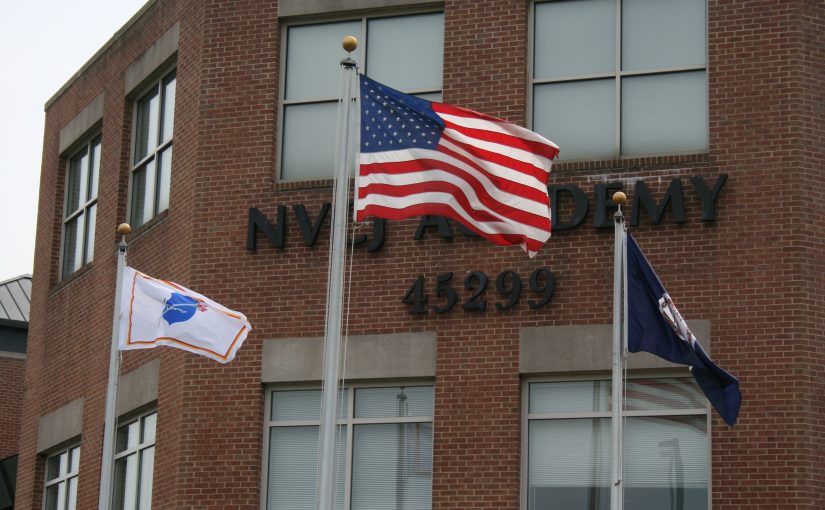There is no doubt that the fatal shooting in Ferguson, Missouri, in 2014 was a watershed moment in U.S. policing. While the impact of the post-Ferguson era in policing has spawned several positive outcomes — one of the most notable being the work of the President’s Task Force on 21st Century Policing — it has also resulted in public views of policing that are increasingly divided along racial lines. Now, as a result of the death of George Floyd at the hands of police officers in Minneapolis, Minnesota, this condition has been exacerbated to a degree that has probably never before existed, and the aftermath is proving to be one of the most defining moments in the history of U.S. law enforcement.
Major policing reforms are coming to cities or counties across the United States, and they are coming soon. And unlike the prior processes for implementing changes affecting policing practices and operations, some of these reforms will be imposed on police leaders from the outside and will be nonnegotiable. While elected officials and community leaders discuss their ideas for police reforms, now would be a good time to review and, if necessary, rethink how law enforcement training can be adapted to enhance service delivery and increase community trust and support. Now, more than ever, police officers and community members alike need to reestablish (or build) relationships that are based on mutual trust and respect.
The foundation for all learning in law enforcement organizations starts in the basic recruit training program. Training begins at the entry level, continues through field training and ongoing annual training, is reinforced through daily supervisory feedback, and continues throughout officers’ entire careers. Newly hired officers immediately learn the values and performance expectations of their agencies in the basic recruit training program. Two critical components of the training function are the culture established in the academy and the ability of trainers to impart the most important values of the law enforcement profession in a consistent and repeated manner.
It is critically important that police officers have the resources and the support to prevent and deter crimes and to help keep communities safe. It is equally important that the community perceives the actions of police officers as being fair and just. In many jurisdictions, the communities that need the police the most often trust them the least. There is something completely wrong with this narrative, and there is an urgent need to find ways to correct it. Meaningful changes to police training can help to rebuild trust and confidence with the communities served. This can best be accomplished by starting with the entry-level training and socialization of police officers.
The Correlation between Academy Culture and Recruit Socialization
Culture has been defined as “the set of shared attitudes, values, goals, and practices that characterizes an institution or organization.”1 The values, beliefs, and behaviors exhibited and reinforced by training instructors creates the foundation for the culture in a police agency. Since recruits view their instructors as police officer role models, it is important that instructors conduct themselves in a highly professional manner.
Equally as important as the content of curriculum in recruit training is the method for conveying this information. There will be times when recruits will necessarily be exposed to intimidation, harsh language, or use of profanity in order to further a specific learning objective, but these times should be limited to purposeful, role-play training scenarios. At all other times, instructors should model and reinforce the positive behaviors rooted in their agency’s core values (e.g., professionalism, fairness, integrity, compassion, accountability, and respect) — behaviors that police leaders would want their recruits to learn in the academy and exhibit to members of the public.
Most law enforcement agencies have characteristics that resemble the military, including a rank structure; a clearly defined chain of command; and, at times, a requirement for members to operate in a command and control environment. For these reasons, it is not surprising that many training academies have developed curriculum, training exercises, and disciplinary practices in their entry-level recruit training classes that also closely resemble military-style training. This model of law enforcement training became the norm for most U.S. police agencies during the 1960s. Since then, training academies in the United States have continued to evolve regarding their training curriculum, adding instruction in topics such as community policing, terrorism, unbiased policing, de-escalation, and managing use of force. One area that has not evolved as much with the changing times is the quasi-military, high-stress environment that still exists in many basic recruit academies.
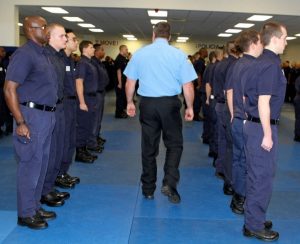 The primary reason identified by those agencies that practice the quasi-military stress model in their academies is the belief that a stressful training environment is necessary to prepare recruits for dealing with challenges they will encounter as law enforcement officers. A major concern when academies operate under this model is that abuses can occur when the behaviors of some instructors degrade into harassment, intimidation, and hazing. Studies of human behavior indicate that some people who are put into positions of power will abuse that power. In other words, those in power (instructors) sometimes mistreat the powerless (recruits). This is not how police agencies should welcome and socialize those just entering the profession.
The primary reason identified by those agencies that practice the quasi-military stress model in their academies is the belief that a stressful training environment is necessary to prepare recruits for dealing with challenges they will encounter as law enforcement officers. A major concern when academies operate under this model is that abuses can occur when the behaviors of some instructors degrade into harassment, intimidation, and hazing. Studies of human behavior indicate that some people who are put into positions of power will abuse that power. In other words, those in power (instructors) sometimes mistreat the powerless (recruits). This is not how police agencies should welcome and socialize those just entering the profession.
In a 2001 Police Foundation article about the abuse of police authority, the authors cautioned that “an organizational culture that sends unclear signals can cause honorable men and women to behave in dishonorable ways.”2 They further emphasized that an organization’s culture should “strike the right balance between achieving an organizational goal and observing fundamental principles of decency and fairness.”3 Too often, this balance is not achieved in high-stress recruit training programs, and sometimes the disciplinary culture goes beyond a stressful environment to one that is abusive. For this reason, it should not be surprising that some police officers mistreat members of the public. In fact, this sentiment about the potential for setting the wrong examples during the inculcation of new police recruits was recently articulated in an article by Georgetown University law professor Rosa Brooks when she related,
It’s not hard to see the link between paramilitary police training and the abuses motivating the past several weeks’ protests. When police recruits are belittled by their instructors and ordered to refrain from responses other than “Yes, Sir!,” they may learn stoicism—but they may also learn that mocking and bellowing orders at those with less power are acceptable actions.4
There can be additional negative influences on the socialization of recruits when instructors abuse their positional power. This scenario was described in a 2015 National Institute of Justice and Harvard Kennedy School article by Sue Rahr, the executive director of the Washington State Criminal Justice Training Commission, and Dr. Stephen Rice, an associate professor of criminal justice, who wrote the following regarding the behavior modeled by instructors in some quasi-military stress academies:
Another, more insidious problem in a military-style academy is the behavior modeled by the academy staff. Those without power (recruits) submit without question to the authority of those who have power (academy staff). Rule violations are addressed by verbal abuse or physical punishment in the form of pushups and extra laps….
Upon graduation, we send our newly trained recruits out into the community—they finally have power. Despite the way they were treated during their training, we expect them to treat the powerless people they encounter in the community with dignity and respect.5
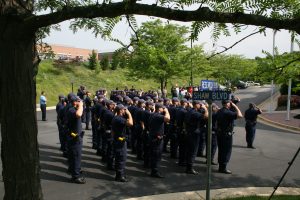 The previous comments reinforce the importance of the role of academy instructors in police culture. Many educators argue that students will model the same behaviors displayed by their teachers during their training experience. Regardless of the type of academy environment that exists, the conduct of the training staff will leave a lasting and memorable impression on recruits. Recruits learn many new ideas and concepts and must demonstrate mastery of numerous academic, physical, and cognitive skills during their training. To be successful, the environment needs to be more highly structured than training for veteran officers; however, the primary focus should be ensuring that recruits are well trained and well prepared for police work. It is even more important to ensure that they are exposed to exemplary role models and the positive behaviors that they will be expected to model when providing police services in their communities.
The previous comments reinforce the importance of the role of academy instructors in police culture. Many educators argue that students will model the same behaviors displayed by their teachers during their training experience. Regardless of the type of academy environment that exists, the conduct of the training staff will leave a lasting and memorable impression on recruits. Recruits learn many new ideas and concepts and must demonstrate mastery of numerous academic, physical, and cognitive skills during their training. To be successful, the environment needs to be more highly structured than training for veteran officers; however, the primary focus should be ensuring that recruits are well trained and well prepared for police work. It is even more important to ensure that they are exposed to exemplary role models and the positive behaviors that they will be expected to model when providing police services in their communities.
Rethinking the Disciplinary Climate in Recruit Academies
Local and state law enforcement agencies do not have a military mission, yet some academies still operate in an environment that is heavily influenced by either a real or perceived military model of training. There are more effective methods that can be employed for preparing recruits for the challenges of law enforcement duties than emulating military training. Transitioning from a quasi-military model to one emphasizing adult learning does not equate to a reduction in high standards or challenging training. Training intended to purposefully induce stress should remain part of the curriculum, but it does not need to be integrated into the majority of the training. The key is to present the training curriculum in a balanced, professional manner and in such a way that allows the recruits to learn effectively. Instructors should consistently model and reinforce the highest degree of professionalism in all interactions with recruits, including in disciplinary situations.
Additionally, the relationship between staff and students should be centered on the principles of procedural justice. Procedurally just behavior includes four central principles:
1. Treating people with dignity and respect
2. Giving individuals “voice” during encounters
3. Being neutral and transparent in decision-making
4. Conveying trustworthy motives6
As pointed out by the President’s Task Force on 21st Century Policing,
There are both internal and external aspects to procedural justice in policing agencies. Internal procedural justice refers to practices within an agency and the relationships officers have with their colleagues and leaders. Research on internal procedural justice tells us that officers who feel respected by their supervisors and peers are more likely to accept departmental policies, understand decisions, and comply with them voluntarily. It follows that officers who feel respected by their organizations are more likely to bring this respect into their interactions with the people they serve.7
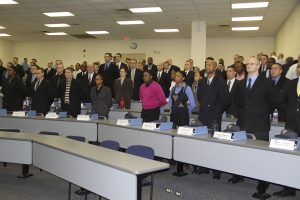 A procedurally just disciplinary philosophy would involve purposeful teaching and purposeful discipline. Many recruits are new to the law enforcement profession and, therefore, do not fully understand the concepts of chain of command and tactical command and control as they apply to the operations of a law enforcement agency. Additionally, the training program for recruits is lengthy and progressive. For these reasons, there are clear differences in the relationships between trainers and recruits in the basic training program compared to those between trainers and veteran officers. During certain simulated exercises, the recruits are—and should be—subjected to profanity, challenging words, and harsh treatment by role players or instructors in order to achieve specific training objectives, as the recruits will likely encounter these during their service. Outside of these purposeful training scenarios, however, recruits should be treated with the same respect that any other student or any visitor to the academy is shown. In the end, reducing the stress level and transitioning away from a boot camp model in recruit training in no way diminishes the quality of the training provided or the performance expectations for the recruits.
A procedurally just disciplinary philosophy would involve purposeful teaching and purposeful discipline. Many recruits are new to the law enforcement profession and, therefore, do not fully understand the concepts of chain of command and tactical command and control as they apply to the operations of a law enforcement agency. Additionally, the training program for recruits is lengthy and progressive. For these reasons, there are clear differences in the relationships between trainers and recruits in the basic training program compared to those between trainers and veteran officers. During certain simulated exercises, the recruits are—and should be—subjected to profanity, challenging words, and harsh treatment by role players or instructors in order to achieve specific training objectives, as the recruits will likely encounter these during their service. Outside of these purposeful training scenarios, however, recruits should be treated with the same respect that any other student or any visitor to the academy is shown. In the end, reducing the stress level and transitioning away from a boot camp model in recruit training in no way diminishes the quality of the training provided or the performance expectations for the recruits.
As Director Rahr and Dr. Rice pointed out, sometimes all that it needed to achieve the same goal is to transition from a “fear and humiliation” style to a coaching style:
The standards for physical performance remain high, and training officers still push the recruits far beyond their physical limits. But, rather than screaming and berating the recruits, the training officers vigorously coach and encourage them to keep pushing. Instead of trying to instill a sense of fear, training officers strive to build a sense of camaraderie and pride for the success of the whole team.8
Since recruits see their instructors as police officer role models, it is important that they do not learn that intimidation, humiliation, belittling comments, or profanity are positive or even acceptable traits of police officers. Instead, instructors should model the positive behaviors (professionalism, respect, compassion, fairness, and empathy) that police leaders would want recruits to exhibit to members of the public once they graduate from the academy.
The Notion of “Warriors and Guardians” in Police Training
Another influence on academy training that is due for a review involves the notion of warrior vs. guardian training. For decades, U.S. political leaders have been declaring various “wars” (e.g., war on crime, war on drugs, and war on terrorism) that have been referred to the police to “fight.” As a result, police training, tactics, and equipment have evolved in order to better prepare officers to successfully prepare for these battles, and training scenarios were mostly designed to teach officers how to win the fight in order to survive. While teaching sound tactics to repel assaults and to overcome resistance is a critically important component of training, in some cases, there was much less emphasis placed on defusing and de-escalating confrontations. Rather than having training that is tailored to either the warrior or to the guardian mentality, police training should be balanced to reflect the realities of today’s community expectations.
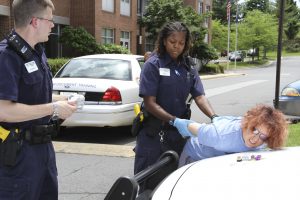 The primary role that most officers perform in the communities in which they serve is that of a guardian who is there to assist and support community members and to protect them from harm. While there are times that an officer may need to use some level of force in order to protect him- or herself or others against assaultive behavior or to manage individuals who are resisting a lawful arrest, the majority of interactions with the public are positive and nonconfrontational. In an article for the Seattle Times, Director Rahr points out the important balance and distinction between these two roles:
The primary role that most officers perform in the communities in which they serve is that of a guardian who is there to assist and support community members and to protect them from harm. While there are times that an officer may need to use some level of force in order to protect him- or herself or others against assaultive behavior or to manage individuals who are resisting a lawful arrest, the majority of interactions with the public are positive and nonconfrontational. In an article for the Seattle Times, Director Rahr points out the important balance and distinction between these two roles:
This is not a simple distinction because the role of a police officer is not one-dimensional. There are times when the guardian officer must fight fierce battles, as a warrior, without hesitation or apology. So guardians must also possess the skills of a warrior. The challenge of training new police recruits is to equip them with the judgment and confidence to properly balance both roles, rather than simply follow orders.
We need police officers with the skills and tenacity of a warrior, but the mindset of a guardian.9
The question about what the proper role moving forward for police officers serving in communities throughout the United States has been answered quite clearly in the past few weeks. Twenty-first century officers must earn and maintain the trust of their communities by outwardly showcasing their value as guardians while inwardly maintaining the skills to fight like warriors when necessary to protect themselves or the public they serve.
Reinforcing the Most Important Themes through Curriculum Integration
Another equally important measure of the quality of recruit training is in the ability of the training staff to successfully repeat and reinforce the themes and messages that an agency values the most. In order to be successful, the training staff needs to understand the importance of these messages — and they must be delivered in a consistent and repeated manner. As an example, academy trainers should focus on several primary areas that should be overriding considerations in any community-police encounter. The training staff should look for numerous opportunities to repeat and reinforce these themes throughout the course of the basic training program. The most important considerations in any interaction should be
1. The sanctity of human life
2. The safety of everyone
3. Integrity—individually and as a profession
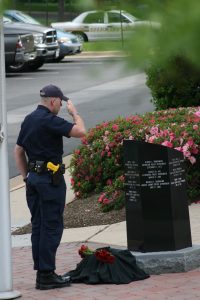 Since preserving the sanctity of life is always most important, trainers and recruits should be more focused on de-escalating potential conflicts, not just for the safety of those they are interacting with, but for their own safety and for that of their fellow officers and bystanders. By extension, this first priority leads right into the second important theme of valuing the safety of everyone. Safety should always be more important than the chase, the arrest, or winning the argument. Finally, it is critically important to stress the importance of integrity as an overriding theme in all officer decision-making. The vast majority of police officers are honest, ethical, and hard-working public servants who do their jobs in an exceptional manner. Unfortunately, it is the dishonorable actions of the few that generate media attention and public notice. Having all police officers performing their jobs with the utmost integrity is a value that needs to be constantly emphasized throughout every training class. Through positive role modeling in a professional training culture and by emphasizing and repeating department core values throughout the basic training program, agencies can better prepare new officers to serve their communities faithfully and fairly.
Since preserving the sanctity of life is always most important, trainers and recruits should be more focused on de-escalating potential conflicts, not just for the safety of those they are interacting with, but for their own safety and for that of their fellow officers and bystanders. By extension, this first priority leads right into the second important theme of valuing the safety of everyone. Safety should always be more important than the chase, the arrest, or winning the argument. Finally, it is critically important to stress the importance of integrity as an overriding theme in all officer decision-making. The vast majority of police officers are honest, ethical, and hard-working public servants who do their jobs in an exceptional manner. Unfortunately, it is the dishonorable actions of the few that generate media attention and public notice. Having all police officers performing their jobs with the utmost integrity is a value that needs to be constantly emphasized throughout every training class. Through positive role modeling in a professional training culture and by emphasizing and repeating department core values throughout the basic training program, agencies can better prepare new officers to serve their communities faithfully and fairly.
Conclusion
It is recognized that law enforcement agencies must evolve in concert with the changing expectations of the communities they serve. To a large extent, this requires changes to the culture of the training environment. Given the important role that training instructors play in the assimilation of new recruits into the law enforcement profession, it is paramount that training staff epitomize the most positive examples of professionalism and procedural justice in the academy setting. Beyond that, through their actions and performance, instructors need to continually model and reinforce to the recruits the importance of performing police duties in a manner that is representative of leading 21st century law enforcement agencies.
The recent, contemptible actions of a few officers have unfairly painted the entire profession with a negative broad brush in the eyes of many. This public vilification has been extremely harmful to the morale of many dedicated public servants, and it is imperative that the profession make changes from within to improve its standing with the public. This effort is owed to the current officers on the front lines, as well as helping to ensure that this negative public sentiment will not dissuade the best and brightest from the next generation from becoming the police’s newest recruits. Now, more than at any other time in recent history, the law enforcement profession needs highly ethical and compassionate people to join its ranks and to steer the course of U.S. law enforcement in a more positive direction. 🛡
Notes:
1 Merriam-Webster Dictionary, s.v. culture.
2 David Weisburd et al., The Abuse of Police Authority: A National Study of Police Officers’ Attitudes (Washington, DC: Police Foundation, 2001), 9.
3 Weisburd et al., The Abuse of Police Authority, 9.
4 Rosa Brooks, “Stop Training Police Like They’re Joining the Military,” The Atlantic, June 10, 2020.
5 Sue Rahr and Stephen K. Rice, From Warriors to Guardians: Recommitting American Police Culture to Democratic Ideals, New Perspectives in Policing (Washington, DC: National Institute of Justice, 2015), 4.
6 President’s Task Force on 21st Century Policing, Final Report of the President’s Task Force on 21st Century Policing (Washington, DC: Office of Community Oriented Policing Services, 2015), 10.
7President’s Task Force on 21st Century Policing, Final Report of the President’s Task Force on 21st Century Policing, 10.
8 Rahr and Rice, From Warriors to Guardians, 9.
9 Sue Rahr, “Guest: From Warriors to Guardians—Returning American Police Culture to Democratic Ideals,” Seattle Times, August 26, 2014.
Please cite as
William C. O’Toole, “Start at the Beginning: Changing Police Culture by Changing Recruit Training,” Police Chief Online, July 8, 2020.


